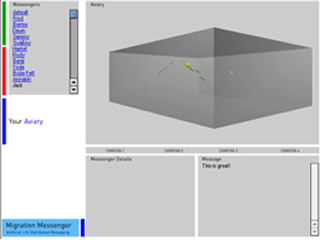Following on from the Prototype collaboration piece I continued with my interest in social interaction and navigation with a purely digital project “Migration Messenger”.
I am really pleased that I seemed to spot an emerging, now prolific, market: Social Software. I feel that Migration Messenger would possibly overcome some of the problems with Social Software through its unique distribution method.
Migration messenger was a continuation of my investigation in to social interaction, which started with the ‘Prototype’ project. “This project requires you to set a problem as well as provide a solution. Projects are to be negotiated with your tutor through an initial proposal. It is essential that the production of work is informed by a critical debate that you have identified.”
I identified two parts to my critical debate: The ‘Macro’ and ‘Micro’ aspects of social navigation. Prototype was informed by the conversation that took place between the ‘actual’ and the ‘virtual’ user, thus exploring the advantages and limitations of the implementation of augmented reality and its effect on the sensory aspect of social navigation. The very personal, in fact one-on-one, relationship between users demonstrates the ‘Micro’ level of human social interaction. Our lives are full of these intimate moments of interaction.
After the success of the collaboration on ‘Prototype’ I decided to further investigate what social interaction on a broader scale means to users across the largest scale of digital communications we currently have: the Internet.
I observed that most communication occurs as a point-to-point process. I know who I am sending a message to, they know who they are receiving a message from and neither of us are aware of the gulf that lies between us. This gave me the idea of creating a medium of communication that integrates the ‘journey’ of the message in to the communication process. The most popular systems of messaging at the moment online are ‘instant messengers’ such as MSN messenger or Yahoo messenger etc. So I decided to borrow the users’ semantic knowledge of these applications to coax them in to a different way of sharing ideas and information. Strongly influenced by the A-Life work of Karl Sims and Craig Reynolds, Migration Messenger uses the analogy of carrier pigeons in the digital realm. The user creates a message, which is represented by a ‘bird’ that is launched in to their personal aviary. These birds then ‘flock’ in the user’s aviary until specific criteria are met which allows them to migrate to one of the nearest neighbours on the network, taking the message and details about themselves and their author with them.
This process requires the user to download the Migration Messenger Client software, in to which they enter their details, which are carried by every messenger that the user creates. The software connections run through Shockwave Multiuser Server enabling rapid transmission from node to node across the network as the messengers migrate.
Due to time constraints and the need for a steep learning curve I was only able to develop a prototype of the Migration Messenger software. I hope to be able to return to this project when I have a firmer grasp on the technology needed, so that I can test out this new medium of mass communication.




Posted by Sam at January 16, 2004 02:34 PM
